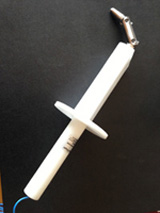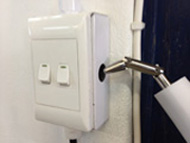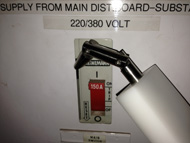I HAVE found that the ‘finger test' is one of the least understood aspects in electrical installations so it is not
 surprising that the ‘jointed test finger' is an instrument that is conspicuous by its absence... which is rather surprising when one considers that one of the primary safety requirements applicable to all electrical installations is ‘access to live parts'.
surprising that the ‘jointed test finger' is an instrument that is conspicuous by its absence... which is rather surprising when one considers that one of the primary safety requirements applicable to all electrical installations is ‘access to live parts'.
Over the last few months, a colleague and I have made some attempts to ascertain the availability of this ‘instrument' and alas, it is not generally available.
(Seen here: The Standard test finger - SANS IEC 60529).
This creates - and it has been the case over many years - the problem of identifying live parts that may be accessible with the ‘standard test finger' when this instrument is not being used for the test. This ‘assumed' accessibility to live parts has, therefore, become dependent on the average size of the ‘Registered Persons' finger and the obvious disadvantage for those Registered Persons who have smaller than average fingers!
What concerns me particularly, is the use of the ‘standard test finger' by Registered Persons testing electrical installations when issuing Certificates of Compliance so let's look at the legislation pertaining to access to live parts as specifically detailed in SANS 10142-1, Clause 5.1.1 i.e.
5.1.1 Live parts
It shall not be possible to touch any live part within arm's reach with the standard test finger (see SANS 60529)
a) during normal operation, or
b) when a cover is removed, unless the cover is removed with the use of a tool or a key.
It is important to note that SANS 10142-1 refers to the standard SANS 60529 and that the specifications of SANS 60529 make provision for ‘the degrees of protection' provided by enclosures (IP Code). Annex J in SANS 10142-1 (informative) is an extract from SANS 60529/IEC 60529
When dealing with this particular requirement, note also that ‘the IP rating of the standard test finger' is more fully detailed in SANS 60529.
In relation to Annex J and SANS 60529, the IP code element is given as IP2X.


(from left to right: Clear access for test finger - now to test for live parts and Ensuring no access with the jointed test finger on distribution board)
How do we interpret the IP Code and what does this mean?
The IP code - defined in the second edition of ‘IEC60529 Degrees of Protection provided by
enclosures (IP code)' - consists of two numerals and two optional extra letters. The first numeral ‘0', 1...6, or ‘X' defines the protection against ingress of solid foreign objects and against access to hazardous parts.
The second numeral ‘0', ‘1...8', or ‘X' defines the protection against the ingress of water.
Put simply, therefore, to comply with the provisions of SANS 10142-1 means that "the full penetration of a 12,5mm diameter of sphere is not allowed. The jointed test finger shall have adequate clearance from hazardous parts."
To pass the test for the first characteristic numerals ‘1', '2', '3' and ‘4' against solid foreign objects (in this case IP2), it is satisfactory if the full diameter of probe does not pass through any opening.
In essence then, as we are dealing with an instrument in terms of determining compliance with a Standard, it becomes necessary to have such an instrument.
Reference should be made to SANS 60529 for full specifications.
Contact: Cindy
Phone: +86-13751010017
E-mail: sales@iecgauges.com
Add: 1F Junfeng Building, Gongle, Xixiang, Baoan District, Shenzhen, Guangdong, China